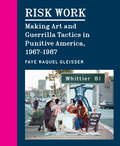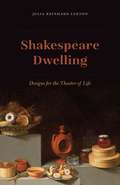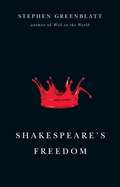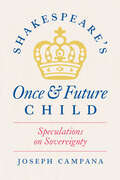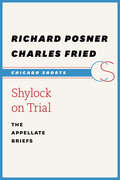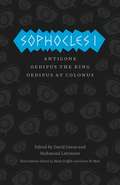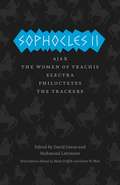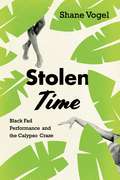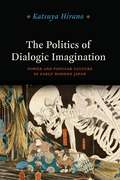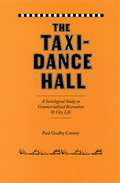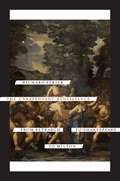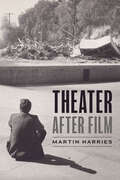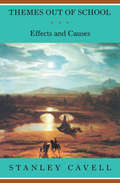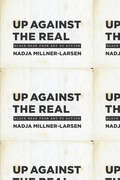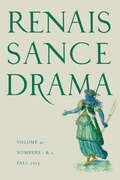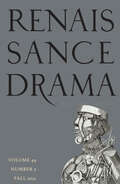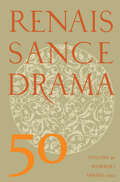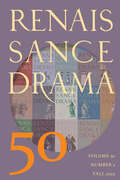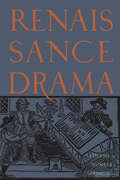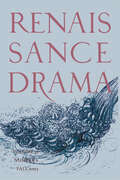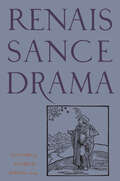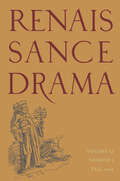- Table View
- List View
Risk Work: Making Art and Guerrilla Tactics in Punitive America, 1967–1987
by Faye Raquel GleisserHow artists in the US starting in the 1960s came to use guerrilla tactics in performance and conceptual art, maneuvering policing, racism, and surveillance. As US news covered anticolonialist resistance abroad and urban rebellions at home, and as politicians mobilized the perceived threat of “guerrilla warfare” to justify increased police presence nationwide, artists across the country began adopting guerrilla tactics in performance and conceptual art. Risk Work tells the story of how artists’ experimentation with physical and psychological interference from the late 1960s through the late 1980s reveals the complex and enduring relationship between contemporary art, state power, and policing. Focusing on instances of arrest or potential arrest in art by Chris Burden, Adrian Piper, Jean Toche, Tehching Hsieh, Pope.L, the Guerrilla Girls, Asco, and PESTS, Faye Raquel Gleisser analyzes the gendered, sexualized, and racial politics of risk-taking that are overlooked in prevailing, white-centered narratives of American art. Drawing on art history and sociology as well as performance, prison, and Black studies, Gleisser argues that artists’ anticipation of state-sanctioned violence invokes the concept of “punitive literacy,” a collectively formed understanding of how to protect oneself and others in a carceral society.
Shakespeare Dwelling: Designs for the Theater of Life
by Julia Reinhard LuptonGreat halls and hovels, dove-houses and sheepcotes, mountain cells and seaside shelters—these are some of the spaces in which Shakespearean characters gather to dwell, and to test their connections with one another and their worlds. Julia Reinhard Lupton enters Shakespeare’s dwelling places in search of insights into the most fundamental human problems. Focusing on five works (Romeo and Juliet, Macbeth, Pericles, Cymbeline, and The Winter’s Tale), Lupton remakes the concept of dwelling by drawing on a variety of sources, including modern design theory, Renaissance treatises on husbandry and housekeeping, and the philosophies of Hannah Arendt and Martin Heidegger. The resulting synthesis not only offers a new entry point into the contemporary study of environments; it also shows how Shakespeare’s works help us continue to make sense of our primal creaturely need for shelter.
Shakespeare's Freedom
by Stephen GreenblattShakespeare lived in a world of absolutes—of claims for the absolute authority of scripture, monarch, and God, and the authority of fathers over wives and children, the old over the young, and the gentle over the baseborn. With the elegance and verve for which he is well known, Stephen Greenblatt, author of the best-selling Will in the World, shows that Shakespeare was strikingly averse to such absolutes and constantly probed the possibility of freedom from them. Again and again, Shakespeare confounds the designs and pretensions of kings, generals, and churchmen. His aversion to absolutes even leads him to probe the exalted and seemingly limitless passions of his lovers. Greenblatt explores this rich theme by addressing four of Shakespeare’s preoccupations across all the genres in which he worked. He first considers the idea of beauty in Shakespeare’s works, specifically his challenge to the cult of featureless perfection and his interest in distinguishing marks. He then turns to Shakespeare’s interest in murderous hatred, most famously embodied in Shylock but seen also in the character Bernardine in Measure for Measure. Next Greenblatt considers the idea of Shakespearean authority—that is, Shakespeare’s deep sense of the ethical ambiguity of power, including his own. Ultimately, Greenblatt takes up Shakespearean autonomy, in particular the freedom of artists, guided by distinctive forms of perception, to live by their own laws and to claim that their creations are singularly unconstrained. A book that could only have been written by Stephen Greenblatt, Shakespeare’s Freedom is a wholly original and eloquent meditation by the most acclaimed and influential Shakespearean of our time.
Shakespeare's Once and Future Child: Speculations on Sovereignty
by Joseph CampanaA study of Shakespeare’s child figures in relation to their own political moment, as well as our own. Politicians are fond of saying that “children are the future.” How did the child become a figure for our political hopes? Joseph Campana’s book locates the source of this idea in transformations of childhood and political sovereignty during the age of Shakespeare, changes spectacularly dramatized by the playwright himself. Shakespeare’s works feature far more child figures—and more politically entangled children—than other literary or theatrical works of the era. Campana delves into this rich corpus to show how children and childhood expose assumptions about the shape of an ideal polity, the nature of citizenship, the growing importance of population and demographics, and the question of what is or is not human. As our ability to imagine viable futures on our planet feels ever more limited, and as children take up legal proceedings to sue on behalf of the future, it behooves us to understand the way past child figures haunt our conversations about intergenerational justice. Shakespeare offers critical precedents for questions we still struggle to answer.
Shylock on Trial: The Appellate Briefs
by Charles Fried Richard PosnerWilliam Shakespeare is inextricably linked with the law, his plays rich in its terms, settings, and thought processes. In Shylock on Trial: The Appellate Briefs, the Hon. Richard A. Posner and Charles Fried rule on Shakespeare's classic drama The Merchant of Venice. Framed as a decision argued by two appellate judges of the period in a trial following Shylock's sentencing by the Duke of Venice, these essays playfully walk the line between law and culture, dissecting the alleged legal inconsistencies of Shylock's trial while engaging in an artful reading of the play itself. The resultant opinions shed fresh light on the relationship between literary and legal scholarship, demonstrating how Shakespeare's thinking about legal concepts and legal practice points to a deep and sometimes vexed engagement with the law's technical workings, its underlying premises, and its social effects.
Sophocles I
by Sophocles David Grene Richmond Lattimore Glenn W. Most Mark GriffithSophocles I contains the plays "Antigone," translated by Elizabeth Wyckoff; "Oedipus the King," translated by David Grene; and "Oedipus at Colonus," translated by Robert Fitzgerald. Sixty years ago, the University of Chicago Press undertook a momentous project: a new translation of the Greek tragedies that would be the ultimate resource for teachers, students, and readers. They succeeded. Under the expert management of eminent classicists David Grene and Richmond Lattimore, those translations combined accuracy, poetic immediacy, and clarity of presentation to render the surviving masterpieces of Aeschylus, Sophocles, and Euripides in an English so lively and compelling that they remain the standard translations. Today, Chicago is taking pains to ensure that our Greek tragedies remain the leading English-language versions throughout the twenty-first century. In this highly anticipated third edition, Mark Griffith and Glenn W. Most have carefully updated the translations to bring them even closer to the ancient Greek while retaining the vibrancy for which our English versions are famous. This edition also includes brand-new translations of Euripides' Medea, The Children of Heracles, Andromache, and Iphigenia among the Taurians, fragments of lost plays by Aeschylus, and the surviving portion of Sophocles's satyr-drama The Trackers. New introductions for each play offer essential information about its first production, plot, and reception in antiquity and beyond. In addition, each volume includes an introduction to the life and work of its tragedian, as well as notes addressing textual uncertainties and a glossary of names and places mentioned in the plays. In addition to the new content, the volumes have been reorganized both within and between volumes to reflect the most up-to-date scholarship on the order in which the plays were originally written. The result is a set of handsome paperbacks destined to introduce new generations of readers to these foundational works of Western drama, art, and life.
Sophocles II
by Sophocles David Grene Richmond Lattimore Glenn W. Most Mark GriffithSophocles II contains the plays "Ajax," translated by John Moore; "The Women of Trachis," translated by Michael Jameson; "Electra," translated by David Grene; "Philoctetes," translated by David Grene; and "The Trackers," translated by Mark Griffith. Sixty years ago, the University of Chicago Press undertook a momentous project: a new translation of the Greek tragedies that would be the ultimate resource for teachers, students, and readers. They succeeded. Under the expert management of eminent classicists David Grene and Richmond Lattimore, those translations combined accuracy, poetic immediacy, and clarity of presentation to render the surviving masterpieces of Aeschylus, Sophocles, and Euripides in an English so lively and compelling that they remain the standard translations. Today, Chicago is taking pains to ensure that our Greek tragedies remain the leading English-language versions throughout the twenty-first century. In this highly anticipated third edition, Mark Griffith and Glenn W. Most have carefully updated the translations to bring them even closer to the ancient Greek while retaining the vibrancy for which our English versions are famous. This edition also includes brand-new translations of Euripides' Medea, The Children of Heracles, Andromache, and Iphigenia among the Taurians, fragments of lost plays by Aeschylus, and the surviving portion of Sophocles's satyr-drama The Trackers. New introductions for each play offer essential information about its first production, plot, and reception in antiquity and beyond. In addition, each volume includes an introduction to the life and work of its tragedian, as well as notes addressing textual uncertainties and a glossary of names and places mentioned in the plays. In addition to the new content, the volumes have been reorganized both within and between volumes to reflect the most up-to-date scholarship on the order in which the plays were originally written. The result is a set of handsome paperbacks destined to introduce new generations of readers to these foundational works of Western drama, art, and life.
Stolen Time: Black Fad Performance and the Calypso Craze
by Shane VogelIn 1956 Harry Belafonte’s Calypso became the first LP to sell more than a million copies. For a few fleeting months, calypso music was the top-selling genre in the US—it even threatened to supplant rock and roll. Stolen Time provides a vivid cultural history of this moment and outlines a new framework—black fad performance—for understanding race, performance, and mass culture in the twentieth century United States. Vogel situates the calypso craze within a cycle of cultural appropriation, including the ragtime craze of 1890s and the Negro vogue of the 1920s, that encapsulates the culture of the Jim Crow era. He follows the fad as it moves defiantly away from any attempt at authenticity and shamelessly embraces calypso kitsch. Although white calypso performers were indeed complicit in a kind of imperialist theft of Trinidadian music and dance, Vogel argues, black calypso craze performers enacted a different, and subtly subversive, kind of theft. They appropriated not Caribbean culture itself, but the US version of it—and in so doing, they mocked American notions of racial authenticity. From musical recordings, nightclub acts, and television broadcasts to Broadway musicals, film, and modern dance, he shows how performers seized the ephemeral opportunities of the fad to comment on black cultural history and even question the meaning of race itself.
The Oresteia: Agamemnon, Women At The Graveside, Orestes In Athens (Oleander Language And Literature Ser. #Vol. 18)
by AeschylusHighly acclaimed as translators of Greek and Sanskrit classics, respectively, David Grene and Wendy Doniger O'Flaherty here present a complete modern translation of the three plays comprising Aeschylus' Orestia and, with the assistance of director Nicholas Rudall, an abridged stage adaptation. This blanced and highly successful collaboration of scholars with a theater director solves the contemporary problems of translating and staging the Orestia, which originally was written to be performed in Athens in the first half of the fifth century B.C. While remaning faithful to the original Greek, Grene and O'Flaherty embrace a strong and adventurous English style, vivid and visceral. The language of this extraordinary translation, immediately accessible to a theater audience, speaks across the centuries. Premiered at Chicago's Court Theater in 1986 under Rudall's direction, the stage adaptation of the Orestia proved eminently playable. This new adaptation of the orestia offers a brilliant demonstration of how clearly defined goals (here, the actor's needs) can inspire translators to produce fresh, genuine, accessible dramatic texts. The resulting work provides complete and accurate texts for those who cannot read the original Greek, and it transforms the Orestia into an effective modern stage play. With interpretive introductions written by the translators and director, this new version will be welcomed by teachers of translation courses, by students of Greek and world drama in general, and by theater professionals.
The Politics of Dialogic Imagination: Power and Popular Culture in Early Modern Japan (Chicago Studies in Practices of Meaning)
by Katsuya HiranoIna"The Politics of Dialogic Imagination," Katsuya Hirano seeks to understand why, with its seemingly unrivaled power, the Tokugawa shogunate of early modern Japan tried so hard to regulate the ostensibly unimportant popular culture of Edo (present-day Tokyo)OCoincluding fashion, leisure activities, prints, and theater. He does so by examining the works of writers and artists who depicted and celebrated the culture of play and pleasure associated with EdoOCOs street entertainers, vagrants, actors, and prostitutes, whom Tokugawa authorities condemned to be detrimental to public mores, social order, and political economy. Hirano uncovers a logic of politics within EdoOCOs cultural works that was extremely potent in exposing contradictions between the formal structure of the Tokugawa world and its rapidly changing realities. He goes on to look at the effects of this logic, examining policies enacted during the next eraOCothe Meiji periodOCothat mark a drastic reconfiguration of power and a new politics toward ordinary people under modernizing Japan. Deftly navigating JapanOCOs history and culture, a"The Politics of Dialogic Imagination"provides a sophisticated account of a country in the process of radical transformationOCoand of the intensely creative culture that came out of it. "
The Taxi-Dance Hall: A Sociological Study in Commercialized Recreation and City Life
by Paul G. CresseyFirst published in 1932, The Taxi-Dance Hall is Paul Goalby Cressey’s fascinating study of Chicago’s urban nightlife—as seen through the eyes of the patrons, owners, and dancers-for-hire who frequented the city’s notoriously seedy “taxi-dance” halls. Taxi-dance halls, as the introduction notes, were social centers where men could come and pay to dance with “a bevy of pretty, vivacious, and often mercenary” women. Ten cents per dance was the usual fee, with half the proceeds going to the dancer and the other half to the owner of the taxi-hall. Cressey’s study includes detailed maps of the taxi-dance districts, illuminating interviews with dancers, patrons, and owners, and vivid analyses of local attempts to reform the taxi-dance hall and its attendees. Cressey’s study reveals these halls to be the distinctive urban consequence of tensions between a young, diverse, and economically independent population at odds with the restrictive regulations of Prohibition America. Thick with sexual vice, ethnic clashes, and powerful undercurrents of class, The Taxi-Dance Hall is a landmark example of Chicago sociology, perfect for scholars and history buffs alike.
The Unrepentant Renaissance
by Richard StrierWho during the Renaissance could have dissented from the values of reason and restraint, patience and humility, rejection of the worldly and the physical? These widely articulated values were part of the inherited Christian tradition and were reinforced by key elements in the Renaissance, especially the revival of Stoicism and Platonism. This book is devoted to those who did dissent from them. Richard Strier reveals that many long-recognized major texts did question the most traditional values and uncovers a Renaissance far more bumptious and affirmative than much recent scholarship has allowed. The Unrepentant Renaissance counters the prevalent view of the period as dominated by the regulation of bodies and passions, aiming to reclaim the Renaissance as an era happily churning with surprising, worldly, and self-assertive energies. Reviving the perspective of Jacob Burckhardt and Nietzsche, Strier provides fresh and uninhibited readings of texts by Petrarch, More, Shakespeare, Ignatius Loyola, Montaigne, Descartes, and Milton. Strier's lively argument will stir debate throughout the field of Renaissance studies.
Theater after Film
by Martin HarriesA study of the impact of film and mass culture on drama after World War II. In Theater after Film, Martin Harries argues that after 1945, as cinema became omnipresent in popular culture, theater had to respond to cinema’s hegemony. Theater couldn’t break that hegemony, but it could provide a zone of contestation. Theater made film’s domination of the cultural field visible through hyperbole, refusal, and other strategies, thereby unsettling its power. Postwar theatrical experiment, Harries shows, often channeled and represented film’s mass cultural force, while knowing that it could never possess that force. Throughout the book, Harries brings critical theory into contact with theories of performance. Although Theater after Film treats the theatrical work of many figures, its central focus falls on Tennessee Williams, Samuel Beckett, and Adrienne Kennedy. Discussions of these dramatists consider their ways of addressing spectators, the politics of race between film and theater, and the place of the theatrical apparatus. Readings of these central figures in twentieth-century theater exemplify the book’s historical engagement with the media surround that drama confronted. This confrontation, Harries shows, was central to the development of some of the most continually compelling postwar drama.
Themes Out Of School: Effects and Causes
by Stanley CavellIn the first essay of this book, Stanley Cavell characterizes philosophy as a "willingness to think not about something other than what ordinary human beings think about, but rather to learn to think undistractedly about things that ordinary human beings cannot help thinking about, or anyway cannot help having occur to them, sometimes in fantasy, sometimes as a flash across a landscape. " Fantasies of film and television and literature, flashes across the landscape of literary theory, philosophical discourse, and French historiography give Cavell his starting points in these twelve essays. Here is philosophy in and out of "school," understood as a discipline in itself or thought through the works of Shakespeare, Molière, Kierkegaard, Thoreau, Brecht, Makavejev, Bergman, Hitchcock, Astaire, and Keaton.
Up Against the Real: Black Mask from Art to Action
by Nadja Millner-LarsenA history of 1960s activist art group Black Mask. With Up Against the Real, Nadja Millner-Larsen offers the first comprehensive study of the group Black Mask and its acrimonious relationship to the New York art world of the 1960s. Cited as pioneers of now-common protest aesthetics, the group’s members employed incendiary modes of direct action against racism, colonialism, and the museum system. They shut down the Museum of Modern Art, fired blanks during a poetry reading, stormed the Pentagon in an antiwar protest, sprayed cow’s blood at the secretary of state, and dumped garbage into the fountain at Lincoln Center. Black Mask published a Dadaist broadside until 1968, when it changed its name to Up Against the Wall Motherfucker (after line in a poem by Amiri Baraka) and came to classify itself as “a street gang with analysis.” American activist Abbie Hoffman described the group as “the middle-class nightmare . . . an anti-media phenomenon simply because their name could not be printed.” Up Against the Real examines how and why the group ultimately rejected art in favor of what its members deemed “real” political action. Exploring this notorious example of cultural activism that rose from the ruins of the avant-garde, Millner-Larsen makes a critical intervention in our understanding of political art.
Up Against the Real: Black Mask from Art to Action
by Nadja Millner-LarsenA history of 1960s activist art group Black Mask. With Up Against the Real, Nadja Millner-Larsen offers the first comprehensive study of the group Black Mask and its acrimonious relationship to the New York art world of the 1960s. Cited as pioneers of now-common protest aesthetics, the group’s members employed incendiary modes of direct action against racism, colonialism, and the museum system. They shut down the Museum of Modern Art, fired blanks during a poetry reading, stormed the Pentagon in an antiwar protest, sprayed cow’s blood at the secretary of state, and dumped garbage into the fountain at Lincoln Center. Black Mask published a Dadaist broadside until 1968, when it changed its name to Up Against the Wall Motherfucker (after line in a poem by Amiri Baraka) and came to classify itself as “a street gang with analysis.” American activist Abbie Hoffman described the group as “the middle-class nightmare . . . an anti-media phenomenon simply because their name could not be printed.” Up Against the Real examines how and why the group ultimately rejected art in favor of what its members deemed “real” political action. Exploring this notorious example of cultural activism that rose from the ruins of the avant-garde, Millner-Larsen makes a critical intervention in our understanding of political art.
Up Against the Real: Black Mask from Art to Action (Mersion: Emergent Village Resources For Communities Of Faith Ser.)
by Nadja Millner-LarsenA history of 1960s activist art group Black Mask. With Up Against the Real, Nadja Millner-Larsen offers the first comprehensive study of the group Black Mask and its acrimonious relationship to the New York art world of the 1960s. Cited as pioneers of now-common protest aesthetics, the group’s members employed incendiary modes of direct action against racism, colonialism, and the museum system. They shut down the Museum of Modern Art, fired blanks during a poetry reading, stormed the Pentagon in an antiwar protest, sprayed cow’s blood at the secretary of state, and dumped garbage into the fountain at Lincoln Center. Black Mask published a Dadaist broadside until 1968, when it changed its name to Up Against the Wall Motherfucker (after line in a poem by Amiri Baraka) and came to classify itself as “a street gang with analysis.” American activist Abbie Hoffman described the group as “the middle-class nightmare . . . an anti-media phenomenon simply because their name could not be printed.” Up Against the Real examines how and why the group ultimately rejected art in favor of what its members deemed “real” political action. Exploring this notorious example of cultural activism that rose from the ruins of the avant-garde, Millner-Larsen makes a critical intervention in our understanding of political art.
RD vol 41 num 12
by The University of Chicago PressThis is volume 41 issue 12 of Renaissance Drama. Renaissance Drama explores the rich variety of theatrical and performance traditions and practices in early modern Europe and intersecting cultures. The sole scholarly journal devoted to the full expanse of Renaissance theatre and performance, the journal publishes articles that extend the scope of our understanding of early modern playing, theatre history, and dramatic texts and interpretation, encouraging innovative theoretical and methodological approaches to these traditions, examining familiar works, and revisiting well-known texts from fresh perspectives.
Renaissance Drama, volume 49 number 2 (Fall 2021)
by Renaissance DramaThis is volume 49 issue 2 of Renaissance Drama. Renaissance Drama explores the rich variety of theatrical and performance traditions and practices in early modern Europe and intersecting cultures. The sole scholarly journal devoted to the full expanse of Renaissance theatre and performance, the journal publishes articles that extend the scope of our understanding of early modern playing, theatre history, and dramatic texts and interpretation, encouraging innovative theoretical and methodological approaches to these traditions, examining familiar works, and revisiting well-known texts from fresh perspectives.
Renaissance Drama, volume 50 number 1 (Spring 2022)
by Renaissance DramaThis is volume 50 issue 1 of Renaissance Drama. Renaissance Drama explores the rich variety of theatrical and performance traditions and practices in early modern Europe and intersecting cultures. The sole scholarly journal devoted to the full expanse of Renaissance theatre and performance, the journal publishes articles that extend the scope of our understanding of early modern playing, theatre history, and dramatic texts and interpretation, encouraging innovative theoretical and methodological approaches to these traditions, examining familiar works, and revisiting well-known texts from fresh perspectives.
Renaissance Drama, volume 50 number 2 (Fall 2022)
by Renaissance DramaThis is volume 50 issue 2 of Renaissance Drama. Renaissance Drama explores the rich variety of theatrical and performance traditions and practices in early modern Europe and intersecting cultures. The sole scholarly journal devoted to the full expanse of Renaissance theatre and performance, the journal publishes articles that extend the scope of our understanding of early modern playing, theatre history, and dramatic texts and interpretation, encouraging innovative theoretical and methodological approaches to these traditions, examining familiar works, and revisiting well-known texts from fresh perspectives.
Renaissance Drama, volume 51 number 1 (Spring 2023)
by Renaissance DramaThis is volume 51 issue 1 of Renaissance Drama. Renaissance Drama explores the rich variety of theatrical and performance traditions and practices in early modern Europe and intersecting cultures. The sole scholarly journal devoted to the full expanse of Renaissance theatre and performance, the journal publishes articles that extend the scope of our understanding of early modern playing, theatre history, and dramatic texts and interpretation, encouraging innovative theoretical and methodological approaches to these traditions, examining familiar works, and revisiting well-known texts from fresh perspectives.
Renaissance Drama, volume 51 number 2 (Fall 2023)
by Renaissance DramaThis is volume 51 issue 2 of Renaissance Drama. Renaissance Drama explores the rich variety of theatrical and performance traditions and practices in early modern Europe and intersecting cultures. The sole scholarly journal devoted to the full expanse of Renaissance theatre and performance, the journal publishes articles that extend the scope of our understanding of early modern playing, theatre history, and dramatic texts and interpretation, encouraging innovative theoretical and methodological approaches to these traditions, examining familiar works, and revisiting well-known texts from fresh perspectives.
Renaissance Drama, volume 52 number 1 (Spring 2024)
by Renaissance DramaThis is volume 52 issue 1 of Renaissance Drama. Renaissance Drama explores the rich variety of theatrical and performance traditions and practices in early modern Europe and intersecting cultures. The sole scholarly journal devoted to the full expanse of Renaissance theatre and performance, the journal publishes articles that extend the scope of our understanding of early modern playing, theatre history, and dramatic texts and interpretation, encouraging innovative theoretical and methodological approaches to these traditions, examining familiar works, and revisiting well-known texts from fresh perspectives.
Renaissance Drama, volume 52 number 2 (Fall 2024)
by Renaissance DramaThis is volume 52 issue 2 of Renaissance Drama. Renaissance Drama explores the rich variety of theatrical and performance traditions and practices in early modern Europe and intersecting cultures. The sole scholarly journal devoted to the full expanse of Renaissance theatre and performance, the journal publishes articles that extend the scope of our understanding of early modern playing, theatre history, and dramatic texts and interpretation, encouraging innovative theoretical and methodological approaches to these traditions, examining familiar works, and revisiting well-known texts from fresh perspectives.
